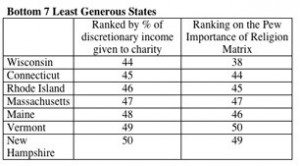Religion and Giving in Wisconsin
- Share
- Tweet
- Pin
- Share
Door County is the most generous community in one of the least generous states in America.
In several columns over the last few months, I’ve discussed what drives the high levels of giving in Door County. Now it’s time to talk about Wisconsin’s relative lack of generosity.
To review, the “How America Gives” study examined more than 35 million tax returns and calculated the average discretionary income (leftover income after a community’s cost of living is accounted for) in each community in the United States. The percentage of discretionary income that is donated to charity gives us the most accurate way to compare giving from one community to the next.
The study’s data clearly proves that Door County is easily the most generous county in Wisconsin, donating an average of 4.1% of our discretionary income to charity. We who call Door County home should feel good about our generosity when compared to the 71 other counties that are our Wisconsin peers. Unfortunately, Wisconsin as a whole does not measure up very well compared to its peers of the 49 other states.
First a mea culpa. I stated in a previous column that Wisconsin was 45th out of 50 states, but I neglected to account for ties and the District of Columbia. When the states are ranked individually, Wisconsin is actually 44th. That’s certainly one step better, but still puts Wisconsin in pretty cheap company. Wisconsin residents donate an average of 3.4% of discretionary income to charity – a whopping 28% below than the national average!
In fact, if Wisconsin wanted to move into the list of the top 5 most generous states, every single Wisconsin resident would have to double the amount of money they give to charity. Clearly it’s financially possible for Wisconsin residents to be more generous – the residents of 43 other states have proven that – but what is it that is keeping Wisconsin from maximizing its generosity? Understanding the role religion plays in giving is a key factor in answering that question.
The greatest predictor of a state’s generosity is the importance of religion to its citizens. The Pew Forum on Religion & Public Life published a study in 2009 which calculated the “importance of religion” to each state in the union. The factors measured were “worship attendance,” “frequency of prayer,” and “belief in god.” Since Wisconsin is the seventh least generous state, it seems appropriate to start by looking at how those statistics correlate among the seven most generous states in the country.

Five of the seven most religious states are also ranked in the top seven most generous states. The only two exceptions are Utah and Idaho. However, Utah has the highest percentage of residents that belong to the Church of Jesus Christ of Latter-Day Saints and Idaho has the second highest percentage. Mormons are traditionally are called upon to tithe, and that dramatically increases the level of giving in those states.
We should remember that churches themselves are non-profit organizations and they collect about 1 out of every 3 dollars given to charity. More money is given to churches in the United States than all the universities, arts and culture organizations, environmental groups and human service charities combined. Next time you take a drive around the peninsula, just look at all the charitable dollars our community has spent on church buildings. The greatest and most majestic places we’ve built for non-profit organizations are not the YMCA, Peninsula Players, the Art School or Birch Creek. Rather, they are our houses of worship.
This isn’t a criticism of religion. Over the last year my family has reconnected with our spirituality and our new church has quickly become a very important part of our life. But the fact remains that giving to churches is by far the largest piece of the charitable pie. As a result, the importance of religion to a state has a direct impact on its total generosity. The statistics among the least generous states correlate even more closely than among the most generous states.

Six of the seven least generous states also rank among the seven least religious states in the nation. Wisconsin is a slight exception, ranking as the 38th most religious state, but that appears to be more of a factor of how close the raw scores are among the bottom states rather than something fundamentally different about Wisconsin’s relatively low level of giving.
Of course, one should not conclude that only the pious are generous. The “How America Gives” study divided the nation into four regions – West, Midwest, South and Northeast – and ranked their collective generosity overall, and again after removing religious giving from the statistics.

When church giving is excluded, the south and northeast regions switch places. Southern states donate 30% more than northeastern states when all kinds of charitable giving is included. But northeastern states donate an incredible 67% more to charity than southern states if you exclude gifts to churches from the equation.
Ultimately, your personal giving has little to do with Wisconsin’s poor showing or even Door County’s top ranking in the state. Those are just statistics that paint a picture in the aggregate. What each of us do as individuals is entirely up to us. Find your passion, then be generous with your friendship and finances to the causes most important to you.
